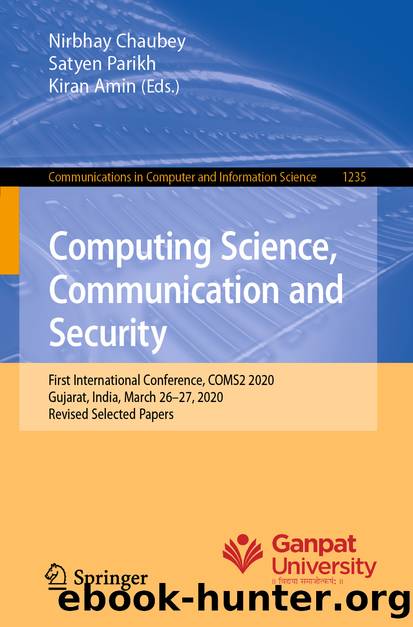Computing Science, Communication and Security by Unknown

Author:Unknown
Language: eng
Format: epub
ISBN: 9789811566486
Publisher: Springer Singapore
The PS strategy in LTE-A and 5G networks is not standardized by 3GPP, therefore performance depends on the implementation designed by each mobile cellular network operator or developer. In general, most of the scheduling schemes presented in the literature can be classified according to information used for decision-making process, such as QoS requirements, and channel conditions (Channel-Aware Scheduling).
The scheduling scheme operation that consider channel conditions can be summarized as follows. At each Transmission Time Interval (TTI), UEs estimate the channel condition and report the Channel Quality Indicator (CQI) to serving eNB. This is so-called CQI feedback [5]. In eNB there is a buffer for each UE, where incoming packets are queued and has to wait for scheduling opportunity. The scheduling strategy, whose decision-making process takes channel condition into account, can allocate one or more RBs to particular UEs, and a RRM module determines the Modulation and Coding Scheme (MCS) according to CQI feedback. For instance, RBs are allocated to high SINR UEs in each cell in order to maximize system throughput because the better the channel condition, the higher the MCS order and, hence, the higher the bit rate per RB. This is an opportunistic scheduling example that is efficient for exploiting variations in channel conditions to produce significant network throughput gains.
The effectiveness of these schemes depends on the channel condition information provided by the UEs. Outdated information may result in poor performance.
In general, the PS design should consider a mathematical model, so-called utility function, to quantify system performance. The utility function result may vary with each TTI according to the UE-to-RB mapping established by the scheduling strategy. The parameterization of this function depends on the project objective. Some examples of scheduling algorithms that consider channel conditions are Maximum Throughput (MT), whose purpose is to maximize system throughput; another example is the Proportional Fairness (PF), whose objective is the balance between spectral efficiency (SE) and fairness. In the Eqs. (1) and (2) are presented utility functions of MT and PF algorithms, respectively [3].
Download
This site does not store any files on its server. We only index and link to content provided by other sites. Please contact the content providers to delete copyright contents if any and email us, we'll remove relevant links or contents immediately.
POP by Steven Heller(2882)
Japanese Design by Patricia J. Graham(2554)
The Power of Broke by Daymond John(2376)
Architecture 101 by Nicole Bridge(2349)
Fusion 360 for Makers by Lydia Sloan Cline(1986)
Indistractable: How to Control Your Attention and Choose Your Life by Nir Eyal(1932)
Origami Art by Michael G. Lafosse & Richard L. Alexander(1733)
Batik by Rudolf Smend(1719)
Actionable Gamification: Beyond Points, Badges, and Leaderboards by Yu-kai Chou(1718)
Homebody by Joanna Gaines(1709)
Worn in New York by Emily Spivack(1617)
Feng Shui by Stephen Skinner(1616)
Whiskey in a Teacup by Reese Witherspoon(1574)
Austin Kleon by Steal Like an Artist(1535)
Don't Make Me Think, Revisited: A Common Sense Approach to Web Usability by Steve Krug(1525)
Simple Gatherings by Melissa Michaels(1510)
Hygge: The Danish Art of Happiness by Marie Tourell Søderberg(1426)
The Joy of Hygge by Jonny Jackson(1340)
The Laws of Simplicity by John Maeda(1299)
